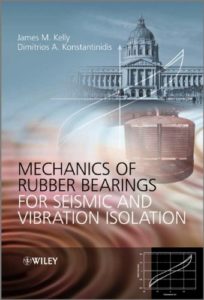Mechanics of Rubber Bearings for Seismic and Vibration Isolation
Mechanics of Rubber Bearings for Seismic and Vibration Isolation
Mechanics of Rubber Bearings for Seismic and Vibration Isolation covers multilayer rubber bearings have been used as seismic isolation devices for buildings in highly seismic areas in many countries. Their appeal in these applications comes from their ability to provide a component with high stiffness in one direction with high flexibility in one or more orthogonal directions. This combination of vertical stiffness with horizontal flexibility, achieved by reinforcing the rubber by thin steel shims perpendicular to the vertical load, enables them to be used as seismic and vibration isolators for machinery, buildings and bridges.Mechanics of Rubber Bearings for Seismic and Vibration Isolation collates the most important information on the mechanics of multilayer rubber bearings.
You can also Read Fire Service Hydraulics and Pump Operations
Content
- About the Authors
![Mechanics of Rubber Bearings for Seismic and Vibration Isolation]()
- Preface
- History of Multilayer Rubber Bearings
- Behavior of Multilayer Rubber Bearings under Compression
- Behavior of Multilayer Rubber Bearings under Bending
- Steel Stress in Multilayer Rubber Bearings under Compression and Bending
- Buckling Behavior of Multilayer Rubber Isolators
- Buckling of Multilayer Rubber Isolators in Tension
- Influence of Plate Flexibility on the Buckling Load of Multilayer Rubber Isolators
- Frictional Restraint on Unbonded Rubber Pads
- Effect of Friction on Unbonded Rubber Bearings
- Appendix: Elastic Connection Device for One or More Degrees of Freedom
- References
- Photograph Credits
- Author Index
- Subject Index
These reinforced rubber bearings in their various forms are a source of fascinating problems in solid mechanics. It is the combination of vertical stiffness and horizontal flexibility, achieve by reinforcing the rubber by thin steel plates perpendicular to the vertical load, used in many applications, including the seismic protection of buildings and bridges and the vibration isolation of buildings and machinery.
The horizontal, vertical, and bending stiffnesses are important to the design of bearings for these applications and for predicting the buckling load, the interaction between vertical load and horizontal stiffness, and the dynamic response of structures and equipment mounted on the bearings.


Comments are closed.